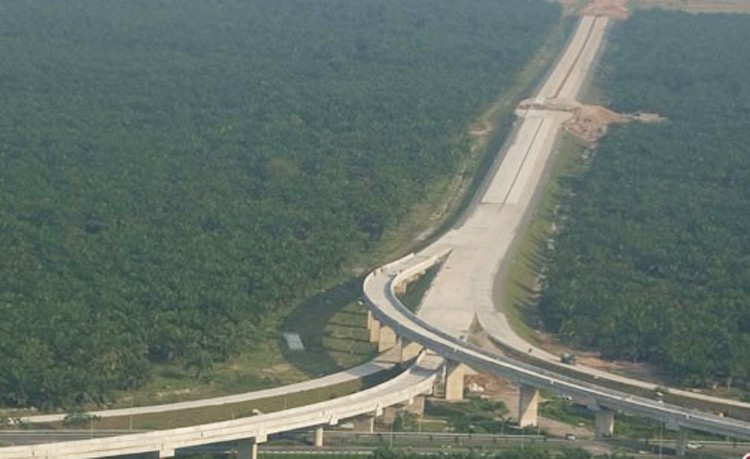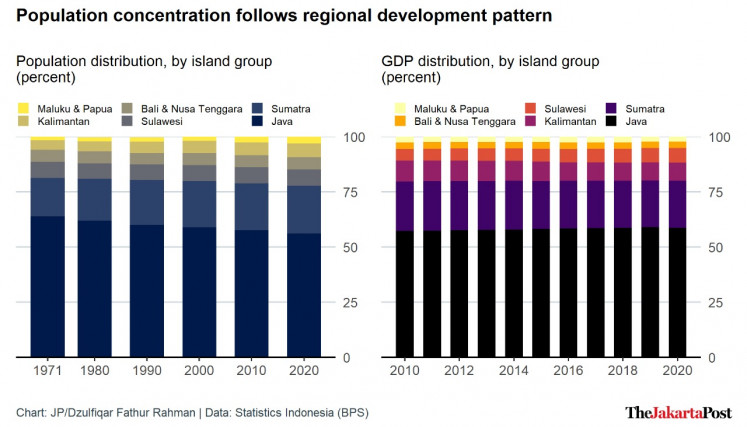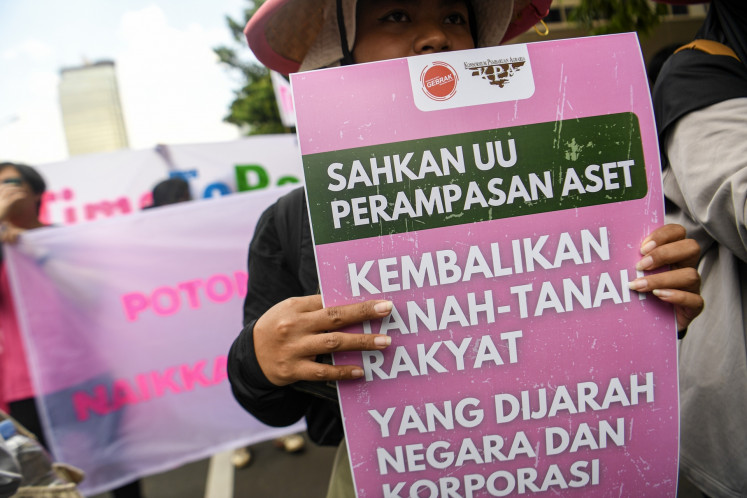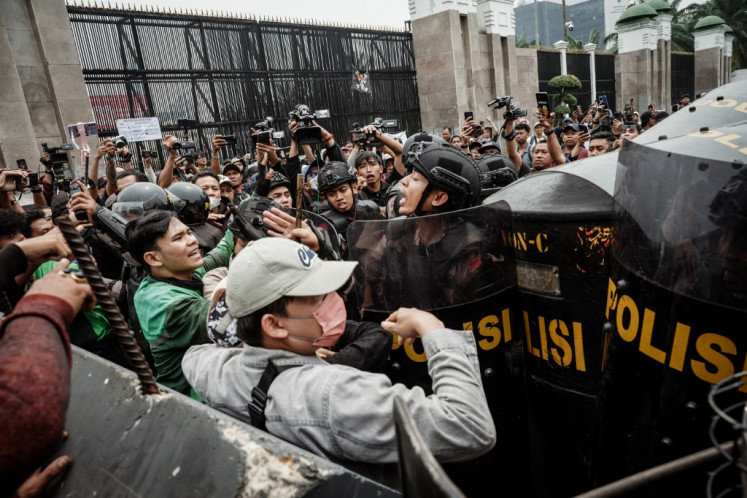Popular Reads
Top Results
Can't find what you're looking for?
View all search resultsPopular Reads
Top Results
Can't find what you're looking for?
View all search resultsIndonesia remains Java-centric despite Jokowi's infrastructure campaign
Java's economic output remains the highest across the country's islands, making it hard to see migration to other cities and provinces outside the country's most populous island.
Change text size
Gift Premium Articles
to Anyone
D
espite the emergence of new urban centers on other islands, the Indonesian population of over 270 million people remains concentrated on Java as other islands still fail to catch up with the development achieved on the country’s most populous island.
Java had roughly 151.6 million people, or around 56.1 percent of the population, as of September last year, according to Statistics Indonesia’s (BPS) latest population census. In contrast, the population of Kalimantan, which has an area four times larger than Java, accounted for 6.15 percent of the total population.
“Inequality in development is one of the factors behind the unequal population distribution,” BPS researcher Nashrul Wajdi told The Jakarta Post on Saturday. “Java remains a ‘magnet’ for migrants from outside the island.”
Read also: Do or die as youth dominate demographics
The concentration of population follows the unequal distribution of Indonesia’s gross domestic product (GDP). Java’s economic output accounted for 58.7 percent of the country’s GDP in the January–March period, followed by Sumatra, Kalimantan, Sulawesi, Bali and Nusa Tenggara, as well as Maluku and Papua.
Transmigration program
The government has sought to shift the population distribution with the transmigration program, from the time of the Dutch colonial government until that of the President Joko “Jokowi” Widodo administration.
Between 1971 and 1990, the share of Java’s population declined by around 2 percentage points and that of Sumatra and Kalimantan got larger. However, the pace of the shift in the population distribution to islands outside Java has plateaued since 2000, with Sulawesi, Bali and Nusa Tenggara showing a slowdown.
“The fast trend in migration outside Java before the 2000s was a result of the transmigration program aimed at engineering the population redistribution,” Chotib, a mobility researcher at the Demographic Institute of the University of Indonesia’s (UI) School of Economics and Business, told the Post.
“After the 2000s, migration outside Java was more natural as a response to economic opportunities in the destination region.”
Read also: Indonesia's transmigration program moves more people outside Java, but they remain poor
In 1949, then-president Sukarno sought to move 48 million people out of Java over 35 years, according to Nashrul. But even after stretching the period to between 1905 and 2010, the transmigration program had migrated only 7.9 million people.
“As long as there are inequalities in social and economic development, restriction and configuration [policies] related to population mobility appear to have a very small impact on migration,” said Nashrul.
Nashrul added the change in population distribution was not necessarily due to migration, as other factors such as fertility and mortality rates also played a role.
President Jokowi has implemented more expansive programs to develop infrastructure on islands outside of Java. Under his watch, the government has developed major road projects such as the trans-Papua, as well as roads in the peripheral areas of Kalimantan, Sulawesi and Sumatra. It has also developed new industrial zones, also known as special economic zones, on islands other than Java.
But the infrastructure campaign has yet to show significant impacts.
Pull factors and distance constraints
Migrants between provinces were found to be more responsive to what researchers call “pull factors”, which are conditions such as higher income per person and better job opportunities that make a particular destination province more attractive than one's home province.
Provinces with higher income per person tend to have a larger inflow of migrants relative to the population, such as Jakarta, East Kalimantan, Riau Islands, North Kalimantan and Riau. Conversely, the proportion of migrants coming in is smaller in provinces with lower income per person, such as East Nusa Tenggara, Maluku and West Nusa Tenggara.
For recent migrants, whose current place of living is different from that of five years ago, nearly 62 percent worked in the service sector, followed by manufacturing and agriculture, according to the 2019 national social and economic survey (Susenas) of 320,000 households by BPS. Although the majority of migrants worked in the labor force, over one-third did not.
The net lifetime migration relative to the total population, which indicates a province’s population growth as a result of migration, was highest in Riau Islands at 50 percent, followed by North Kalimantan, the survey also found. Riau Islands has the Batam free trade zone and North Kalimantan is the largest oil and gas producing province.
Aside from expected higher income, the migration pattern between provinces was also associated with the distance, as reflected in the migrants to provinces in the western part of Java and Kalimantan who came mostly from the eastern part of Java, BPS found.
In Bali, for example, 53.9 percent of the migrants to the province were from East Java, followed by East Nusa Tenggara, Central Java, West Nusa Tenggara and West Java. In Aceh, 60.2 percent of the migrants were from North Sumatra, followed by Central Java and West Sumatra.
“In our case, the issue lies in infrastructure,” Nawawi, a demographics researcher at the Indonesian Institute of Sciences (LIPI), told the Post in a phone interview on May 17.
“Sea transportation, especially the ports, has been sidelined all this time except for a few cities. It was a mistake in the development design in the past, which was too Java-centric so that connectivity to other regions was forgotten.”
New capital city
The government’s plan to develop a new capital city in North Penajam Paser and Kutai Kartanegara regencies in East Kalimantan has renewed the expectation to nudge more people to move into the province.
Nawawi said the new capital city might only induce a temporary migration if it only moved the center of government without generating a new economic center. On the other hand, Chotib said the new capital city was expected to speed up the balancing of population redistribution.
Read also: South Kalimantan declares state of emergency as flooding displaces more than 20,000
Regardless, pursuing a redistribution policy without improving the distribution of the economic pie risks perpetuating the cycle of population concentration, since provinces with a higher population density tend to have higher income per person.
“The consequence of a population too concentrated in a region clearly has an impact on the distribution and the pace of economic growth between regions,” said Chotib. “Of course, provinces with a more concentrated population will have more attractive economic activities, which lead to faster economic growth.”











